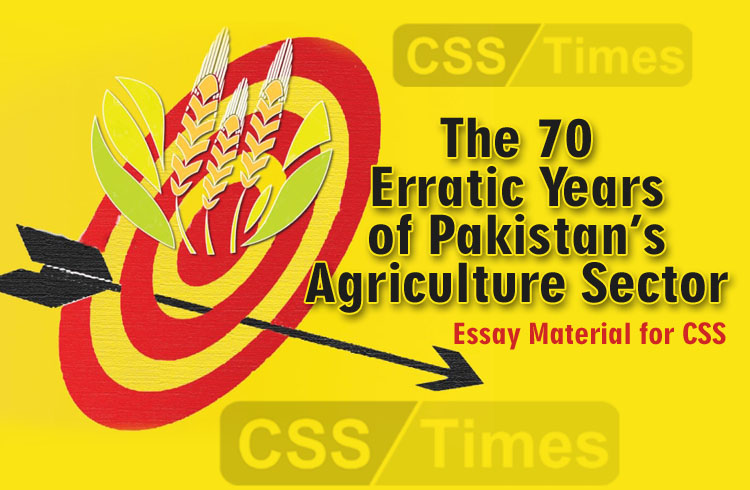With a rich and vast natural resource base covering various climatic and ecological zones, Pakistan ranks eighth in the world in farm output.
It is one of the world’s largest producers and suppliers of food and crops: chickpea (3rd), apricot (6th), cotton, rice and mango (4th), milk sugarcane and date palm (5th), kinnow or citrus (6th), and wheat and onion (7th).
The country’s agricultural sector has three major roles in the national economy: provides food to consumers and fibre to the industry, earns foreign exchange, and provides a market for industrial goods/machinery.
However, the share of agriculture in gross domestic product (GDP) has declined since independence, falling from 53 per cent in 1949-50 to 19.8pc in 2016-17.
From 1947 to 1950, the country produced raw materials for the rest of the subcontinent as well as some other world markets.
But farm products then were compulsory procured at rates less than in the global markets. Inter-district movement and the export of major crops were banned, while wheat and sugar were subsidised for urban consumers.
The sector benefited from the Korean War (1950-53), but an overvalued rupee adversely affected agricultural exports.
Then came the ‘Green Revolution’ of the 1960s that saw agricultural policy considerably relaxed. The Ayub regime introduced land reforms putting a ceiling on individual holdings, the first agricultural university in the country was set up, liberal subsidies were offered for the import of tractors, and tubewells were installed to overcome water scarcity in the wake of Indus Basin Treaty. Moreover, compulsory procurement of farm produce was replaced by voluntary sales.
“Ours is one of the most blessed countries, but those who lead us lack vision as they haven’t come forward on merit”
The average annual growth rate during the decade was 5.07pc. A major water reservoir, Mangla Dam, was also developed which helped bring more area under cultivation. Link canals were constructed for supplying irrigation water to the command areas of the three rivers given to India under the treaty.
The growth rate declined to 2.37pc during the 1970s when nationalisation programme of the government kept production and distribution of key farm products to itself. The benefit of the rupee’s devaluation in the form of higher prices was not transferred to the agricultural sector hampered by export duties and government monopolies. The government also introduced second and third stages of land reforms.
In the 1980s, farm growth rate went up again, posting an annual average of 5.4pc. A new agricultural policy was introduced to bring domestic farm prices on a par with global rates. The Agricultural Price Commission was formed to help the government set support prices.
Through the World Bank’s Structural Adjustment Programme, the farm input and output prices were brought to the prices prevailing in the world markets. Fertiliser subsidies were phased out.
In the 1990s, the growth rate fluctuated between 5.9pc and 4.4pc, as from now on the sector went into major structural changes. Livestock emerged as an important subsector contributing around one-third of the agricultural GDP.
Fisheries and forestry also grew rapidly. In the crop sector, cotton became as import as wheat in terms of value-addition, accounting for one-fifth share of total earnings.
The share of rice and sugar cane, however, fell from 20pc in 1970s to around 15pc in 2014. Export taxes were reduced, better support prices were introduced while efforts were made for timely provision of farm inputs.
In short, the sector covered many milestones as production of various crops — grains, fruit, vegetables — increased manifold in the past 70 years.
For instance, wheat output rose from 3.301m tonnes in 1947 to 25m tonnes in 2014, cotton 0.188m bales to 2.374m bales, mango 0.13m tonnes to 1.716m tonnes, citrus 0.088m tonnes to 2.396m tonnes, and onion from 0.056m in 1947 tonnes to 1.671m tonnes in 2014.
But this performance fails to satisfy some quarters who believe much could have been achieved through better policies.
Check our Collection of English Essays specially for CSS
- Essay Outline: Electoral Reforms in Pakistan: Necessity and Challenges
- Health for All | Essay Outline for CSS PMS
- Exploring the Economic Potential of BRICS Countries: Opportunities and Challenges
- Art and Morality Essay Outline
- Instruction in Youth is Like Engraving in Stone | Complete Essay with Outline
- Public Office is a Public Trust | Complete CSS Essay
- Essay Outline “Good Governance is deeply rooted in Human Development”
- CSS Essay Outline | The Importance of Water Conservation and Management
- How to Write Effective Essay for CSS Exams
- How to Write Effective Essay on Economy? 7 Steps







